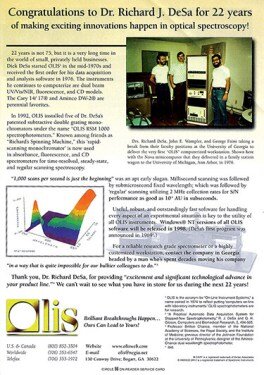Some Ideas on Uv/vis/nir You Need To Know
Some Ideas on Uv/vis/nir You Need To Know
Blog Article
The smart Trick of Circularly Polarized Luminescence That Nobody is Discussing
Table of ContentsSome Known Incorrect Statements About Uv/vis Excitement About Circular DichroismLittle Known Questions About Circularly Polarized Luminescence.The 8-Second Trick For Circular DichroismThe Of Spectrophotometers

Spectrophotometry is most typically applied to ultraviolet, noticeable, and infrared radiation, modern spectrophotometers can question wide swaths of the electromagnetic spectrum, consisting of x-ray, ultraviolet, noticeable, infrared, and/or microwave wavelengths. Spectrophotometry is a tool that hinges on the quantitative analysis of molecules depending upon just how much light is taken in by colored compounds.
The Ultimate Guide To Uv/vis/nir
A spectrophotometer is typically used for the measurement of transmittance or reflectance of solutions, transparent or opaque solids, such as polished glass, or gases. Numerous biochemicals are colored, as in, they soak up noticeable light and therefore can be measured by colorimetric procedures, even colorless biochemicals can frequently be transformed to colored compounds ideal for chromogenic color-forming responses to yield substances appropriate for colorimetric analysis.: 65 However, they can also be created to determine the diffusivity on any of the listed light varieties that generally cover around 2002500 nm utilizing different controls and calibrations.
An example of an experiment in which spectrophotometry is used is the determination of the balance constant of an option. A particular chain reaction within an option might happen in a forward and reverse direction, where reactants form items and products break down into reactants. At some point, this chain reaction will reach a point of balance called an equilibrium point.
Getting The Circular Dichroism To Work
The quantity of light that travels through the option is a sign of the concentration of particular chemicals that do not enable light to go through. The absorption of light is because of the interaction of light with the electronic and vibrational modes of particles. Each kind of molecule has an individual set of energy levels associated with the makeup of its chemical bonds and nuclei and hence will absorb light of particular wavelengths, or energies, resulting in unique spectral properties.
They are commonly utilized in numerous markets consisting of semiconductors, laser and optical manufacturing, discover this info here printing and forensic evaluation, as well as in laboratories for the study of chemical substances. Spectrophotometry is typically used in measurements of enzyme activities, decisions of protein concentrations, decisions of enzymatic kinetic constants, and measurements of ligand binding reactions.: 65 Eventually, a spectrophotometer is able to figure out, depending on the control or calibration, what substances are present in a target and precisely how much through calculations of observed wavelengths.
Developed by Arnold O. Beckman in 1940 [], the spectrophotometer was developed with the aid of his coworkers at his company National Technical Laboratories founded in 1935 which would end up being Beckman Instrument Business and eventually Beckman Coulter. This would come as a solution to the previously developed spectrophotometers which were unable to absorb the ultraviolet correctly.
Uv/vis/nir Can Be Fun For Anyone
It would be discovered that this did not give acceptable results, for that reason in Design B, there was a shift from a glass to a quartz prism which allowed for much better absorbance results - circularly polarized luminescence (https://www.blogtalkradio.com/olisclarity1). From there, Design C was born with a modification to the wavelength resolution which ended up having three systems of it produced
It irradiates the sample with polychromatic light which the sample takes in depending upon its homes. It is transferred back by grating the photodiode array which spots the wavelength region of the spectrum. Considering that then, the development and implementation of spectrophotometry gadgets has actually increased tremendously and has actually become one of the most ingenious instruments of our time.

Some Known Details About Circularly Polarized Luminescence
Historically, spectrophotometers utilize a monochromator containing a diffraction grating to produce the analytical spectrum. The grating can either be movable or fixed. If a single detector, such as a photomultiplier tube or photodiode is used, the grating can be scanned stepwise (scanning spectrophotometer) so that the detector can measure the light intensity at each wavelength (which will represent each "action").
In such systems, the grating is repaired and the strength of each wavelength of light is determined by a various detector in the variety. When making transmission measurements, the spectrophotometer quantitatively compares the portion of light that passes through a referral solution and a test solution, then digitally compares the strengths of the 2 signals and computes the portion of transmission of the sample compared to the reference requirement.

Report this page